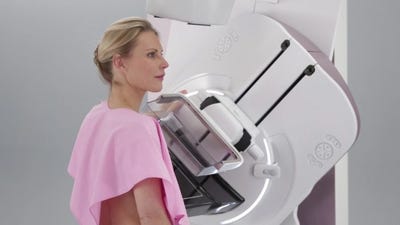February 2, 2017
Tasked with revamping patient perception of mammography, a female product designer at GE Healthcare found a way to put control of the exam in women's hands, literally.
Amanda Pedersen

GE Healthcare's Senographe Pristina allows women to control compression with a remote
Women understand the importance of early detection of breast cancer, but most will put off getting a mammogram for as long as possible.
The reason women delay scheduling a mammogram is simple enough to understand: many are afraid or nervous about the potential result, not to mention the discomfort of the exam itself. But solving the problem hasn't been easy.
Tasked with completely revamping patient perception of mammography, GE Healthcare's Aurelie Boudier found a way to put women in control of their own exam, under the guidance of a technologist. Boudier, global creative director of brand and design language for the company's global design department, also made patient comfort a priority when she designed the Senographe Pristina.
"Pristina has the best of our technology, but it was also inspired by empathy with women," she said.
According to GE, the system is the industry's first self-compression mammography tool. Pristina is operated by a remote control that allows women to adjust the amount of compression pressure they experience during the exam.
"We know that compression can be painful," Boudier said. "This device is more comfortable and the design helps improve patient comfort during detection."
The detector is thinner than conventional mammography systems and features rounded corners so less of the device comes in contact with the woman's bare skin.
The system also positions women in a way that allows them to lean comfortably on the armrests, GE said, relaxing the muscles to simplify image acquisition. Traditionally, the company noted, women are positioned in a way that projects stress on the handles of the machine, which tenses pectoral muscles and impacts image quality.
The design team worked closely with patients, technologists, and radiologists from Gustave Roussy Cancer Center in Paris, France to address concerns of both clinicians and patients.
Boudier also made sure the Senographe Pristina incorporated a soft, metallic pink color, or a more mature pink, as she described it. "It's not Hello Kitty or Barbie pink," she said.
So far, GE said, clinicians and patients have responded favorably to the new design.
"I know that our team did our job if more women are going for their annual mammograms and aren't scared to walk into the room and do the exam," Boudier said. "It's such an important part of maintaining a healthy life, and I want it to be a less painful experience for women around the world."
Amanda Pedersen is Qmed's news editor. Reach her at [email protected]
[Image credit: GE Healthcare]
About the Author(s)
You May Also Like


